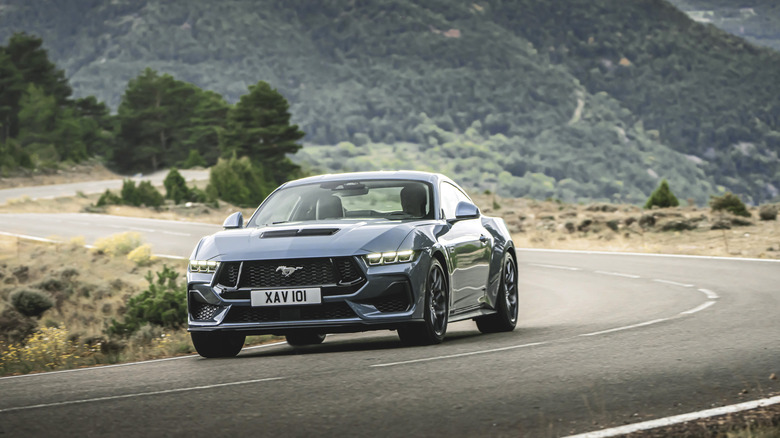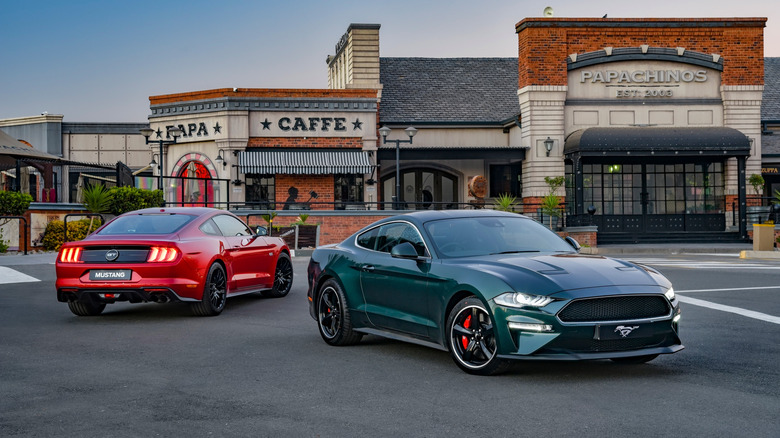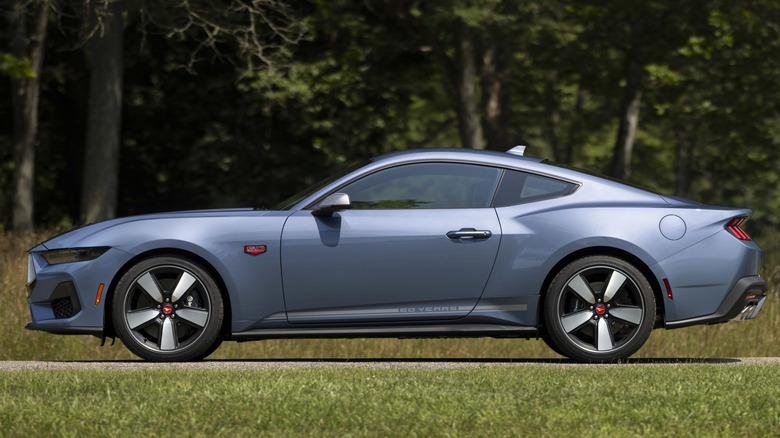Why You Shouldn't Get Your Hopes Up For A Mid-Engine Mustang
Out of all the companies within the Big Three, Ford represents the closest to traditionalism that you can get, at least in terms of sports cars. Its closest comparison used to be the Corvette, which was produced as a front-engine, rear-wheel-drive car for 66 years, but no more as of 2020 (though many earlier 'Vettes dabbled with mid-engine configurations). As for Stellantis, they attempted to axe the Hemi entirely in 2024 as part of an effort to electrify its lineup (that didn't go well).
Ford, meanwhile, actively fought against departures from the traditional Mustang formula, stating that the Mustang would remain a V8 RWD sports car with a manual transmission, but that doesn't stipulate where the engine should be located. After all, the Corvette moved its powerplant amidships, so why not the Mustang? That's probably not going to happen, at least not for the foreseeable future, as there are a number of factors involved in creating a new platform. A hypothetical mid-engine Mustang needs far more than just a platform to make it work; there's the question of marketing, the fact that the Mustang fills a specific niche that no longer faces significant competition in the US, and the potential backlash associated with such a drastic change.
As someone who's written for various specialist Ford and Mustang websites professionally for several years, and is intimately familiar with the history of the platform, I'll explore each of these factors. I'll primarily extrapolate my data from historical evidence along with current-event anecdotes and politics to establish all the problems associated with producing a theoretical mid-engine Mustang.
Creating a mid-engine 2+2 muscle car
Touted as the first truly global Mustang, the modern S650 is unquestionably the most technologically advanced, marketable, and powerful Mustang to date. But all of that is built on a common underlying platform; in this case, the D2C, a basic chassis dating back to 2004, meaning the S650 Mustang we know today uses a design architecture that's 21 years old. According to the general timeline of Mustang platforms, it's likely almost time for a total swap to an all-new design, with the previous entry being the Fox platform. That first entered service in 1978 before evolving to the Fox-4 of the SN95-generation, lasting until the D2C itself. That's a lot of techno-babble to say that the current platform's rapidly reaching its end-of-service life, and Ford's probably thinking of what's next. Why not go mid-engine?
One reason is that it significantly departs from the Mustang's general language, and maintaining that language is next-to-impossible in a mid-engine configuration. Ever since its inception, a Mustang's virtually always been a 2+2 fastback design. That's quite the tall order for a reliable, inexpensive, V8-powered mid-engine sports car; by contrast, the Corvette only has two seats, leaving plenty of room for its engine. Even the modern Porsche 911 still has its engine mounted further rearward, with only the modern 911 RSR (the racing variant) being mid-engined. The Chevrolet Corvair represents the closest example, and that had an air-cooled flat-six. Ford could go transverse or eliminate the back seats to save space, but what would be the point of reinventing the wheel here when the Mustang already occupies an effective monopoly in FR American sports cars?
The economics don't make sense
Let's suppose that you somehow crammed a Coyote V8 (or an entirely new engine) into the middle of a fastback 2+2 body type and made it work. The next question to ask is: what would Ford logically gain from making such a decision? Let's take a look at Ford's closest competition. The Corvette's the obvious pick, but that car is less of a sports car and more of a supercar, not to mention it's over twice the sticker price of a Mustang. What about a Nissan Z, itself an FR 2+2 sports car? It's also more expensive, plus it's less powerful than a similarly priced Mustang GT. A GR Supra, perhaps? It's another outstanding platform, and almost double the Mustang's asking price, with almost 100 fewer horsepower than a Mustang GT.
Ford effectively cornered the FR sports car market in North America in terms of power-for-your-money, and that's before we even consider the crippling effects of the tariffs. By swapping to a mid-engine configuration, Ford would not only have to create a wholly new design language from scratch, but they would also leave behind a lucrative market full of enthusiasts who already enjoy its products. That said, Ford could just pull a 180 and build something totally different like the original idea for the Probe, but that's precisely not what the Mustang nor Ford in general need right now, certainly not during an economic timeframe which analysts and automakers predict will be among the worst in American automotive history. The Probe was a product of its time, the result of Ford's Mazda partnership; these days, there are no similar external factors pulling the Mustang in another direction. In fact, the exact opposite is true: the Mustangs are in a better position than ever today.
The Mustang's current golden age
The Mustang represents the last "true" muscle car after the demise of its closest competition in the Camaro, Charger, Challenger, and so on. Most of these cars were either discontinued entirely or altered so significantly (like the Charger Daytona) that they're no longer considered budget-friendly V8 muscle cars anymore. Arguably, you have the Hemi's return in the Charger Daytona, but with the tariffs hitting Stellantis especially hard, coupled with the already-steep ~$60,000 price tag, this effectively places the Daytona in an entirely different market segment. In other words, if you want the "true" budget muscle car experience in 2025, and you want it with a warranty and the new-car smell, your choices are either a Mustang or another Mustang.
There's something to be said here about the demise of the V8-powered manual-transmission RWD car. But beyond that, Ford has prided itself on building not just the last muscle car in this configuration, but transforming it into some truly outstanding (and extraordinarily fast) machines like the Mustang GTD.
Moreover, the Mustang's reputation expanded dramatically with this latest entry. Ford's flagship sports car became a truly global name for the first time, established itself as a competitive entry in GT3 and GT4 racing, and its reputation was garnered by Ford's public statement for maintaining its traditional design, which endeared it to many enthusiasts and publications. Removing the economics from the equation, there's seldom been a better time for the Mustang in Ford's history, and it accomplished this by maintaining adherence to what works. Deviating from this formula would be a huge gamble with too much risk for too little reward.



